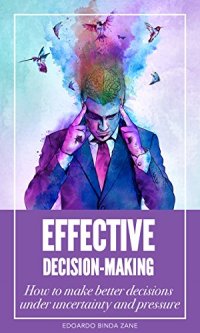THE AIM OF THIS BOOK IS TO QUICKLY EMPOWER YOU TO MAKE BETTER DECISIONS BY GIVING YOU STEP-BY-STEP EXPLANATIONS OF THE BEST AVAILABLE TECHNIQUES.
We always make decisions under uncertainty and pressure, especially in business. We need faster and better decisions to cope, but we don’t have the time to learn how to make them well. That is where I come in. I wrote this book to allow you to make better decisions without spending weeks studying theory and practice.
THE INTRODUCTION gives you a snapshot of two decision-making biases, of the worst mistake you can do when making decision, and a lesson taken straight from philosophy.
– Decision Biases (why your brain isn’t always your friend in decisions)
– The Worst Mistake in Decision-Making
– A Lesson From Another Time
THE FIRST CHAPTER looks at frameworks of reference, meaning how you can apply decision-making to achieve your goals, for example how and why some decisions are able to automatically give you a competitive advantage.
– The OODA Loop
– The Recognition-Primed Decision Model
– GROW or the John Whitmore Model
– The PDSA Cycle
CHAPTERS 2 TO 5 look at separate phases of decision-making: understanding your context, understanding the problem, generating solutions and selecting one option out of many.
2 – CONTEXT
Contexts can be very different – and there is no one size fits all approach, which is why this book provides you with five.
– SWOT and PEST
– TELOS
– Porter’s Five Forces
– Causal Loops Diagrams
3 – PROBLEM ASSESSMENT
Before making decisions, then, you need to work on finding out exactly what you are trying to solve. This chapter gives you 5 tools to do so:
– Root Cause Analysis: Ishikawa’s Diagramand the 5 Whys Technique
– Pareto Analysis
– Kipling Method (5W1H)
– CATWOE
4 – GENERATING IDEAS
In “pure” decision-making, little attention is given to this phase, as it belongs to a different field: creativity. This book includes I two tools that can work fairly well:
– Zwicky’s Box
– SCAMPER
5 – WEIGHING ALTERNATIVES
This is one of the cores of decision-making, and phase most people deal with via a pros and cons list.
This book gives you several tools to make that decision. Each one has its specificities, and with six to choose from, you should be covered for your decisions.
– Weights and Factors: the Grid Analysis and the KT Matrix
– The Paired Comparison Analysis
– The Quantitative Strategic Planning Matrix
– The Analytic Hierarchy Process
– The Eisenhower Matrix
CHAPTER 6 AND 7 look at group decisions, meaning whether it’s a good idea to make decisions in a group and, if it is, how that group should make decisions.
6 – DO YOU NEED YOUR TEAM?
You can either involve your team in decisions or exclude them. Often, managers are torn between these two options – you have three tools to help you though:
– The Vroom-Yetton-Jago Model
– The Hoy-Tarter Model
– The Hersey-Blanchard Model
7 – GROUP TECHNIQUES
To be used when making decisions in a group is necessary.
– The Nominal Group Technique
– The Delphi Method
– Hartnett’s Consensus-Oriented Decision-Making Model
– The Stepladder Technique
– DeBono’s Six Thinking Hats
– The Charette Procedure
– RAPID
CHAPTERS 8 AND 9 look at decisions in corporate strategy and analyse a decision’s consequence
8 – CORPORATE STRATEGY
These decision tools have all been developed for corporations, but they still hold value for smaller businesses.
– The BCG Matrix
– The Advantage Matrix
– The GE Matrix
– Blind Spot Analysis
9 – CONSEQUENCES
In other words: “how can I make sure that the deci












